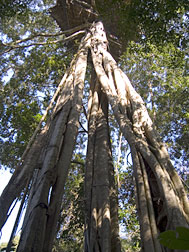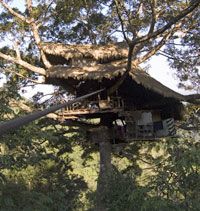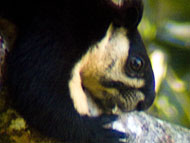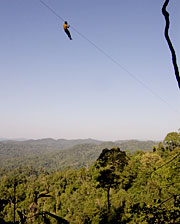I Used to Fly Like Peter Pan
[Update (09/26/06): Many thanks to Ray who left the current link to The Gibbon Experience Website in the comments below. One assumes that the contact form on their site is working…]
[Update (7/31/06): For those of you wanting to do this trek… We arranged things from Luang Prabang via email (they have several addresses on this page). Some people have reported that the gibbon experience email address is not working… your mileage may vary. They do actually have an office in Huay Xai, Laos on the main street near the ferry to Thailand. If you’re crossing over from Thailand walk up the sloped driveway and hang a left. It’s about three doors down on the left (by the way all those people selling you boat tickets along the way are generally a rip off, hitch a ride over to the actual dock and you’ll pay less). Sorry that’s all the information I have. If you know something more I left to comments open below, feel free to add knowledge.]
The next time someone asks you, “would you like to live in a tree house and travel five hundred feet above the ground attached to a zip wire?” I highly suggest you say, “yes, where do a I sign up?”
In my case the signing up happened via email over the internet with a semi-mysterious word-of-mouth-only outfit known as The Gibbon Experience. Luckily Robin was familiar with the Gibbon Experience and insisted that we go and check it out. The journey into the northern part of Laos began inauspiciously at the Luang Prabang bus station where, after waiting three hours, we discovered we had been sold tickets to a bus that was already full. Owing to a lack of time (we needed to be in specific place at a specific time in order to be picked up by the Gibbon Experience truck), we were forced to charter a mini bus from Luang Prabang to Laung Nam Tha. Although not cheap, the mini bus did have one nice part, we got to travel at night and have the next day free to explore Laung Nam Tha. Regrettably there isn’t much to see in Luang Nam Tha, it’s a rather small town on the banks of the Nam Tha River and not much seems to happen there except for the occasional wedding.
 When we finally disembarked at the small village the three of us looked like old men, hair and skin silvered with dust and clothes decided more brown than not. After we straightened out some accommodations with a local family, we deposited our backpacks in their living room and, with the help of the local children, made down to the river where we swam for a while, trying in vain to get the dust off our bodies. Later, after watching the sunset over the hills opposite the river, we had dinner on the porch with the Lao family hosting us. The most common food in Laos is sticky rice and though we did not know it then, that meal marked the beginning an eight-day stretch in which we would eat sticky rice (along with a variety of vegetables) for every meal. Luckily I like sticky rice; Ofir and Robin were decidedly less thrilled with the food.
When we finally disembarked at the small village the three of us looked like old men, hair and skin silvered with dust and clothes decided more brown than not. After we straightened out some accommodations with a local family, we deposited our backpacks in their living room and, with the help of the local children, made down to the river where we swam for a while, trying in vain to get the dust off our bodies. Later, after watching the sunset over the hills opposite the river, we had dinner on the porch with the Lao family hosting us. The most common food in Laos is sticky rice and though we did not know it then, that meal marked the beginning an eight-day stretch in which we would eat sticky rice (along with a variety of vegetables) for every meal. Luckily I like sticky rice; Ofir and Robin were decidedly less thrilled with the food.
The next morning after breakfast, a slightly disconcerting meal that was suspiciously similar to dinner and since it was served cold, I could only assume it was in fact dinner; two trucks pulled into the village with the rest of the people for the trek. Because the tree houses have a limited amount of space, the Gibbon Experience takes only twelve people at a time into the jungle. After meeting the rest of the group (who were traveling from Huay Xui at the other end of the long dusty road), we traveled about two hours up a smaller and even worse road to another village. From there we hiked for roughly two hours to reach the first zip line and tree house. The next tree house was connected to the first by a series of zip lines running through and over the jungle canopy; the highest ran about one hundred fifty meters (500 ft) above the ground. Luckily heights don’t bother me, but some people in our group were clearly nervous the first day. As time went on most people adjusted or just learned to not look down and by the third day we were all zipping around for fun.
Because the tree houses have a limited amount of space, the Gibbon Experience takes only twelve people at a time into the jungle. After meeting the rest of the group (who were traveling from Huay Xui at the other end of the long dusty road), we traveled about two hours up a smaller and even worse road to another village. From there we hiked for roughly two hours to reach the first zip line and tree house. The next tree house was connected to the first by a series of zip lines running through and over the jungle canopy; the highest ran about one hundred fifty meters (500 ft) above the ground. Luckily heights don’t bother me, but some people in our group were clearly nervous the first day. As time went on most people adjusted or just learned to not look down and by the third day we were all zipping around for fun.
 The first night Ofir, Robin and I stayed in the main tree house along with three people from England, and a Scottish man, Donald. After watching the misty clouds form in the valleys below us and eating morning glory leaves with sticky rice, one of the volunteer guides from the Gibbon Experience came up to the tree house and we passed around a bottle of lao lao, which is a local rice whiskey. At some point one of the English lads came up with the idea of slowly cabling out to look at the stars. A few of us clipped onto the zip lines and slowly pulled ourselves out into the pitch black jungle to look up with the stars. As with the camel safari back in India, there were more stars than I have ever seen, and again the giant clouds of the Milky Way were visible with the naked eye, but this time I was seeing it suspended from a wire forty meters in the air. I actually pulled myself all the way over to the hillside opposite the tree house and stood for a while in the darkness of the forest listening to various animals rustling about in the leaves and thinking about the now endangered tigers that may or may not have been lurking close by. Eventually when the mosquitoes found me I took a running leap off the platform and into the complete darkness of the jungle, zipping back toward the warm orange glow of the tree house.
The first night Ofir, Robin and I stayed in the main tree house along with three people from England, and a Scottish man, Donald. After watching the misty clouds form in the valleys below us and eating morning glory leaves with sticky rice, one of the volunteer guides from the Gibbon Experience came up to the tree house and we passed around a bottle of lao lao, which is a local rice whiskey. At some point one of the English lads came up with the idea of slowly cabling out to look at the stars. A few of us clipped onto the zip lines and slowly pulled ourselves out into the pitch black jungle to look up with the stars. As with the camel safari back in India, there were more stars than I have ever seen, and again the giant clouds of the Milky Way were visible with the naked eye, but this time I was seeing it suspended from a wire forty meters in the air. I actually pulled myself all the way over to the hillside opposite the tree house and stood for a while in the darkness of the forest listening to various animals rustling about in the leaves and thinking about the now endangered tigers that may or may not have been lurking close by. Eventually when the mosquitoes found me I took a running leap off the platform and into the complete darkness of the jungle, zipping back toward the warm orange glow of the tree house.
The next day a few people decided to go for a hike to the unfinished fourth tree house which overlooks a waterfall. Having had my fill of waterfalls in Luang Prabang, I decided to lounge around the tree house and get a little writing done. Ofir, one of the girls that works for the Gibbon Experience, and I sat around the tree house most of the morning sharing travel stories and recommendations until a curious creature showed up on one of the extending limbs of the tree. The animal was about the size of a large raccoon with the body and movements of squirrel. According to the girl, who had been there for six months, even the folks at the Gibbon Experience aren’t sure what this animal is called.  The Lao have a word for it, which I can neither pronounce nor spell, but no one seems to know the species name or any English common name for it. If anyone out there recognizes this animal or knows someone who might, contact me since the folks at the Gibbon Experience would like to know what it’s called as well. And just for the record, no it wasn’t that close to me, the close up photograph was taken by pointing my camera lens into the eyepiece of a 75X spotting scope.
The Lao have a word for it, which I can neither pronounce nor spell, but no one seems to know the species name or any English common name for it. If anyone out there recognizes this animal or knows someone who might, contact me since the folks at the Gibbon Experience would like to know what it’s called as well. And just for the record, no it wasn’t that close to me, the close up photograph was taken by pointing my camera lens into the eyepiece of a 75X spotting scope.
For the second night Robin, Ofir and I moved to the smaller and more isolated tree house two. Located about halfway down a long ridge, tree house two has a more commanding view of the surrounding wilderness. It’s also only a twenty-minute walk from tree house three where everybody went to watch the sunset. Walking back in the rapidly approaching darkness was a bit eerie since we all knew from talking to the guides that dusk is the tigers’ favorite hunting time. We never saw any tigers nor any signs of them, but something attacked the pig which lives under tree house one, though it didn’t manage to kill it. The other thing was never saw were the namesake black gibbons, though we did hear them singing in the mornings and evenings.
 The Gibbon Experience was by far the best thing I’ve done so far in my travels and if you ever happen to pass through Huay Xai, Laos I highly recommend it (the office is just up the hill from immigration on your left). So far the project exists solely by word of mouth and even somehow managed to stay out of the Lonely Planet Guidebook. At some point in the next two years the Gibbon Experience will be turned over to the local people who are being trained and supported for now by three volunteers and the French man who started the whole thing. Hopefully it will, as it was intended to do, help show the local villages that sustainable long-term use of the forest is in end more beneficial than the logging and poaching on which much of the local economy currently depends.
The Gibbon Experience was by far the best thing I’ve done so far in my travels and if you ever happen to pass through Huay Xai, Laos I highly recommend it (the office is just up the hill from immigration on your left). So far the project exists solely by word of mouth and even somehow managed to stay out of the Lonely Planet Guidebook. At some point in the next two years the Gibbon Experience will be turned over to the local people who are being trained and supported for now by three volunteers and the French man who started the whole thing. Hopefully it will, as it was intended to do, help show the local villages that sustainable long-term use of the forest is in end more beneficial than the logging and poaching on which much of the local economy currently depends.
Thoughts?
Please leave a reply:
All comments are moderated, so you won’t see it right away. And please remember Kurt Vonnegut's rule: “god damn it, you’ve got to be kind.” You can use Markdown or HTML to format your comments. The allowed tags are
<b>, <i>, <em>, <strong>, <a>. To create a new paragraph hit return twice.